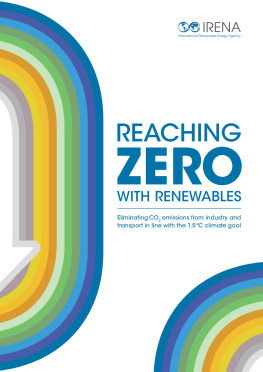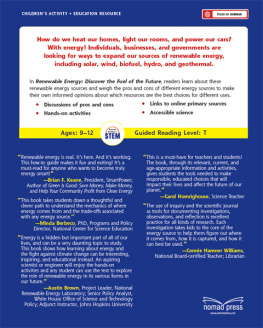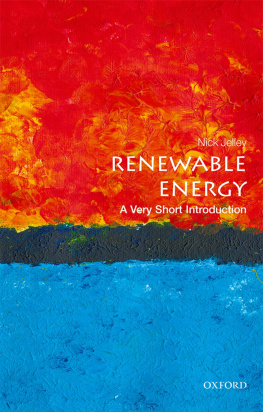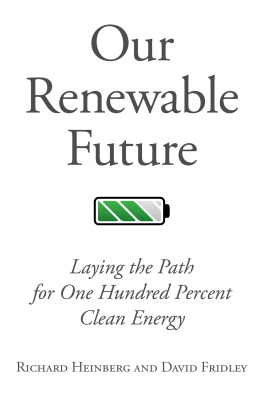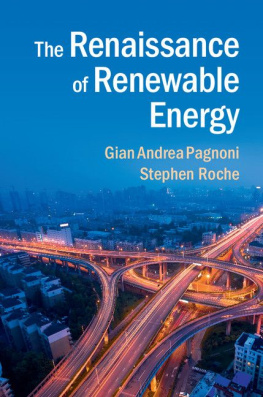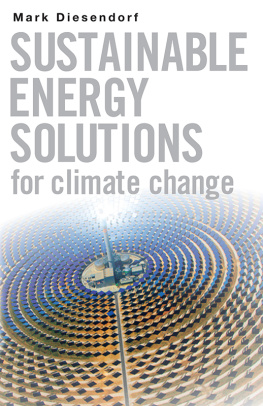Contents
Guide
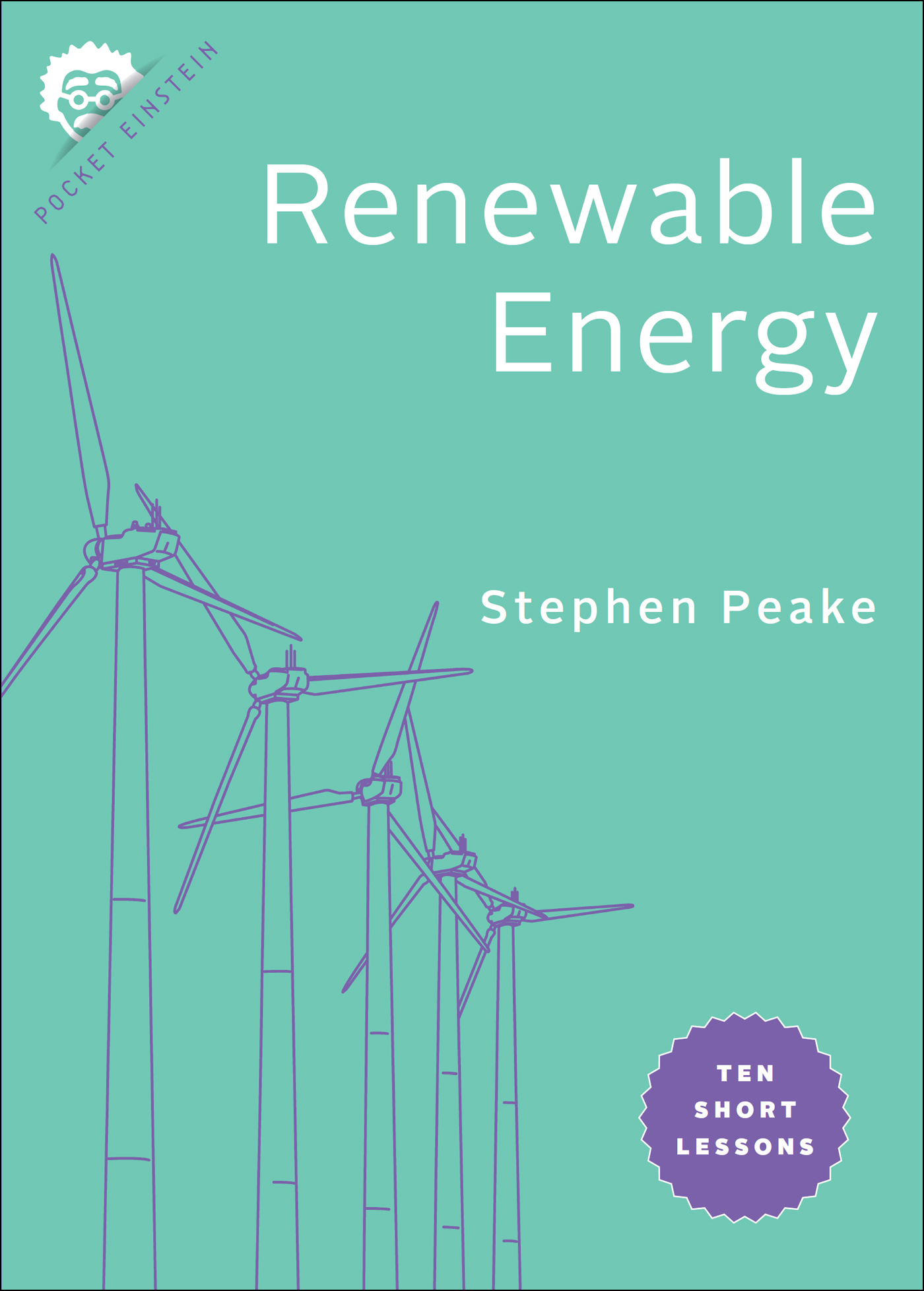
Renewable Energy
Ten Short Lessons
Also in thePOCKET EINSTEINseries
Space Travel: Ten Short Lessons
Artifical Intelligence and Robotics: Ten Short Lessons
Time Travel: Ten Short Lessons
RENEWABLE ENERGY
Ten Short Lessons
Stephen Peake

Johns Hopkins University Press
Baltimore
First published in Great Britain in 2021
by Michael OMara Books Limited
9 Lion Yard
Tremadoc Road
London SW4 7NQ
Copyright Michael OMara Books 2021
All rights reserved.
Printed in the United States of America on acid-free paper
2 4 6 8 9 7 5 3 1
Johns Hopkins University Press
2715 North Charles Street
Baltimore, MD 21218-4363
www.press.jhu.edu
Library of Congress Control Number: 2020952488
ISBN 978-1-4214-4242-6 (paperback : acid-free paper)
ISBN 978-1-4214-4243-3 (ebook)
Designed and typeset by Ed Pickford
Illustrations by David Woodroffe
Special discounts are available for bulk purchases of this book. For more information, please contact Special Sales at specialsales@jh.edu.
Johns Hopkins University Press uses environmentally friendly book materials, including recycled text paper that is composed of at least 30 percent post-consumer waste, whenever possible.
INTRODUCTION
Renewable energy is a no-brainer. Ever since I fell in love with physics at school, Ive been fascinated by the idea of a world powered by 100 per cent renewable energy: quietly, safely, cleanly, peacefully and equitably. It is a reality for an increasing number of companies, cities and nations. Renewable electricity is now cheaper than fossil electricity, and climate change is making it a future necessity for the whole planet.
Renewable energy powered our lives long before fossil fuels and will do so long after. Many of the scientific and technological breakthroughs underpinning the modern forms of renewables, such as biomass, water, wind and solar power, are more than a hundred years old. But we spent the twentieth century mostly investing in fossilized sunshine instead of the real thing: oil from the early 1900s, nuclear electricity to replace some coal in the 1950s, and natural gas in the 1960s. It was in the decade after the 197374 oil crisis that a re-imagining of renewable energy systems occurred as oil prices quadrupled overnight. A long, slow technological fuse was quietly lit.
I was in my teens then, and unaware of an older generation that were already busy explaining the physics of, and digging the foundations for, the explosion of renewable energy that were now experiencing in the twenty-first century. During the first year of my physics degree at the University of Sussex in south-east England, reactor number four at the Chernobyl nuclear power plant in Ukraine went into meltdown, sending a plume of radioactive material into the atmosphere. A week later, an easterly air flow, helped by some very wet weather, deposited a layer of radioactive caesium-137, iodine-131 and strontium-90 over much of the north of England, including my home town of Bolton and my beloved Lake District. It brought some serious questions to the fore. Did we really need nuclear power? Were there not better, safer ways to power economies? Thanks to the vision of such pioneers as Godfrey Boyle, Dave Elliott, Bob Everett, Michael Grubb, Peter Harper, Amory Lovins, Catherine Mitchell, Walt Patterson, Lee Schipper, Brenda Vale and Robert Vale, modern renewable energy is now a real and compelling choice for our energy future.
The Intergovernmental Panel on Climate Change (IPCC) was established in 1988, just as I was starting a PhD on the topic, which was rather niche back then. Three decades later, and climate change and renewable energy are centre stage in mainstream popular culture around the world. Our need to reach zero carbon emissions by 2050, as set out by the IPCC, means that now, more than ever, we have to be both honest and smart as we mix physics and energy policy together in the climate change pot. We urgently need to stop wasting energy and we need to ramp up our investments in renewable energy by ten to twenty times what they are today if we are to meet this important goal.
Fundamentally, renewable energy is about humans tapping into tiny amounts of planetary-scale sources of solar, geothermal and gravitational energy. This book begins by looking at the scale of energy flows in both the natural world and the human world. Through these short chapters, well discover the enormous potential of renewable energy and consider why it is central to limiting dangerous global heating. On our whistle-stop tour of the six major renewable energy resources solar, wind, biomass, hydro, geothermal and ocean well examine the key technologies, old and new, that are driving them forward and the pivotal role that electricity will play in our energy future.
There is an exciting, renewable, electric, peaceful, prosperous, safer future just up ahead. We just need a little more imagination to get there. Thankfully, imagination is renewable, too.
THERES NO SUCH THING AS ENERGY
It is important to realize that in physics today, we have no knowledge of what energy is. We do not have a picture that energy comes in little blobs of a definite amount.
RICHARD FEYNMAN (1963)
There is no such thing as energy. This might come as a bit of a shock. Einsteins famous equation, E = mc 2, tells us that energy equals mass multiplied by the speed of light squared, so there must be such a thing. Energy, it turns out, is much slipperier than our everyday understanding suggests. We might think about paying our energy bills, investment in new energy technologies and the wars that are fought over access to geographical blobs of oil and gas but, intellectually, the scientific idea of energy is mind-bogglingly abstract.
If you were to ask a physicist, What is energy?, they would probably explain it as something that exists in various forms and can be converted from one to another. They might discuss examples of these conversions, before talking about a very important law of physics: that of the conservation of energy, which is the idea that the amount of energy within a defined boundary (or closed system, as physicists would say) remains the same. In other words, energy cannot be created or destroyed.

Energy is a mysterious property that has intrigued and baffled philosophers, mathematicians and scientists for millennia. Variants of the word energy date back to the Greek enrgeia, from en meaning in, and ergon, meaning work. However, none of them were used in the sense of our modern-day scientific understanding of energy as the capacity or potential to do work. The history of exploring the physics of energy is rich in observations about the conversion of energy from one sort to another.
What, in fact, is being conserved is only understood by uncovering the mathematics behind each of the forms of energy in a system. Today, we understand energy at its most fundamental level as mathematics. Before we had uncovered the laws of physics and their various mathematical expressions as they relate to different forms of energy, we had some really fascinating and sometimes strange notions of the



